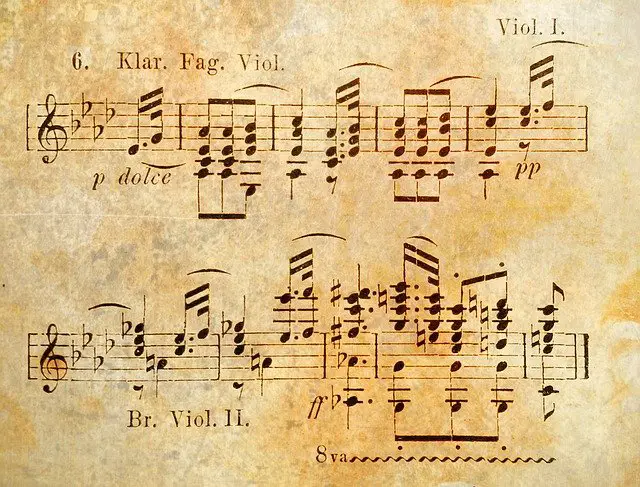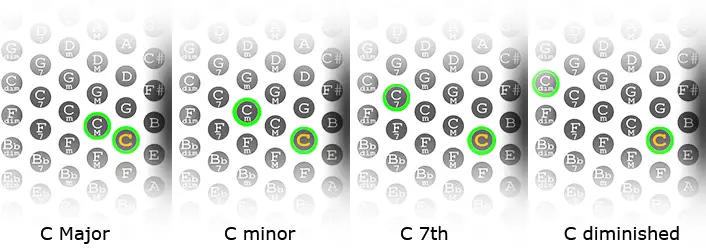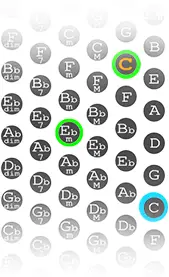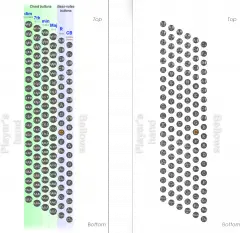Why learn harmony on the accordion?
If you’re interested in learning harmony, the accordion is a fantastic instrument to start on. One of the great things about the accordion is that you can play complete chords with just one button. This makes it a great tool for developing your ear and understanding how chords are constructed. A good place to start is by playing a chord button on the left side and finding the corresponding notes on the right hand. You can also try playing the same chord in both hands for a rich, symphonic sound.

As a beginner accordion player, you can expect to have some initial learning and study involved. This may include becoming familiar with intervals, chord symbols, and understanding the layout of the button board. Let’s dive in:
What is harmony?
Harmony is the science of simultaneous musical combinations or more simply, harmony is playing more than one note together. Playing from 2 up to several notes simultaneously, you get a chord.
- 2 notes chord: Dichord or diad
- 3 notes chord: Trichord or triad
- 4 notes chord: Tetrachord or tetrad
- 5 notes chord: Pentachord or pentad
Harmonic Intervals:
The distance between any two notes that are played at the same time is called harmonic interval and chords are basically stacked intervals.

Consonance and dissonance
Harmony is commonly said to be either consonant or dissonant:
- consonant harmonies sound stable and pleasant
- dissonant harmonies are unstable or create a sense of tension.
Consonant intervals
The intervals that sound consonant are:
- the minor and the major 3rd,
- the perfect 4th,
- the perfect 5th,
- the minor and major 6th,
- the unison,
- and the octave.

The interval on the 3rd it’s quite important because it defines the minor or major nature of the chord. Often people refer to the minor chords as sounding “sad” and major chords as sounding “happy”.
Since minor and major 3rd intervals are consonant, major and minor chords are both consonant chords.
Dissonant intervals
The intervals that sound dissonant are:
- the minor and the major 2nd,
- the minor and the major 7th,
- and the tritone, which is the interval in between the 4th and the 5th.

These intervals sound quite unpleasant or create a tension that suggests another consequent chord.
For example, try to play a C7: we can say that C7 (C – E – G – B♭) creates tension towards FMaj (F – A – C). It’s the minor 7th (B♭) that brings tension because it tends to rise towards a C or to descend towards an A.
Summing up:
- Unison = No difference
- minor 2nd = 1 semitone = 1/2 tone
- Major 2nd = 2 semitone = 1 tone
- minor 3rd = 3 semitone = 1 tone and 1/2
- Major 3rd = 4 semitone = 2 tones
- Perfect 4th = 5 semitone = 2 tones and 1/2
- Tritone = 6 semitone = 3 tones
- Perfect 5th = 7 semitone = 3 tones and 1/2
- minor 6th = 8 semitone = 4 tones
- Major 6th = 9 semitone = 4 tones and 1/2
- minor 7th = 10 semitone = 5 tones
- Major 7th = 11 semitone = 5 tones and 1/2
- Octave = 12 semitone = 6 tones
The Stradella system
The left-hand button board of the accordion is laid out in a pattern called the Stradella System. It makes it easy to play basic chords – major, minor, dominant 7th, diminished 7th – and allows you to play more complex ones combining bass and chords.

Take a better look at the Stradella system layout.
Click to enlarge :
The Stradella system is arranged in a succession of fifths from bottom to top or it can be seen as a sequence of fourths from top to bottom.
This means that starting from the C row toward the top you will find in order:
- G (which is the 5th of C), then
- D (which is the 5th of G), then
- A (which is the 5th of D), then
- E (which is the 5th of A) and so on.
Starting from the C row toward the bottom of the button board you will find in order:
- F (which is the 4th of C), then
- B♭ (which is the 4th of F), then
- E♭ (which is the 4th of B♭), then
- A♭ (which is the 4th of E♭) and so on.
Basic harmony
Having a good grip on basic harmony means that you know how to play basic chord symbols: major, minor, 7th, and diminished.

You should also know the notes that each chord is composed of and be able to pick them out in the left hand and create the same chord with the right hand on the keyboard.
How to build basic chords:
-
Major chords
consist of: root, major 3rd and 5th note of the major scale built on the root.
or
consist of: a major 3rd interval + a minor 3rd interval
Major chord on the right-hand:
So for example, if you want to play a C Major, the root is C, you need to add the major 3rd which is E and the 5th which is G. Between C and E there’s a major 3rd interval, between E and G there’s a minor 3rd interval.
Another example: let’s say you want to build the D Major chord; pick the root D and add a 3rd major interval (4 semitones = 2 tones). Counting 4 semitones from D, you get F# (because between E and F there’s just a semitone). Now find the 5th adding a minor 3rd interval (3 semitones = 1 tone and a 1/2) to F#: the 5th is A.
Major chords on the Stradella system:
Stradella bass system allows you to play major chords on the accordion by pushing just one button on the 3rd column.
-
Minor chords
consist of: root, minor 3rd and 5th note of the major scale built on the root.
or
consist of a minor 3rd interval + a major 3rd interval
Minor chord on the right-hand:
In this case, if you want to play a C minor, play the root, C, the minor 3rd which is a 3rd less a semitone, E♭ and then the 5th, G. Between C and E♭ there’s a minor 3rd interval, between E♭ and G there’s a major 3rd interval.
Minor chord on the Stradella system:
You can play minor chords on the accordion by pushing just one button on the 4th column.
Seventh chords are tetrads (4 notes chords) but they are built on major chords so you need to add just one note to complete them:
-
Dominant seventh (7th) chords*
consist of: major chord + minor 7th note (ex.: C + E + G + B♭)
or
consist of a major 3rd interval + a minor 3rd interval + a 3rd minor interval
Dominant seventh (7th) chords on the right-hand:
Play the major chord and add the minor 7th or build this chord simply by adding two 3rd minor to a major 3rd interval.
Dominant seventh (7th) chords on the Stradella system:
You can find 7th chords on the 5th column of the button board.
(*Usually, the 7th chord buttons on the accordion actually play the root, the 3rd, and the 7th. The 5th is omitted. On the French system (3 columns of chords + 3 columns of single notes) and on some 40, 60, or 80 bass accordions, the 7th chords buttons play the 3rd, the 5th and the 7th omitting the root.)
-
Diminished seventh (7th) chords**
consist of a minor chord with diminished 5th
or
consist of a minor 3rd interval + a minor 3rd interval
Diminished seventh (7th) chords on the right-hand:
Play the minor chord and flatten the 5th or build this chord simply by combining two 3rd minor intervals.
Diminished seventh (7th) chords on the Stradella system:
You can find diminished chords on the 6th column of the button board.
(**The diminished chord buttons on the accordion actually play diminished 7th chords without the 5th, in other words, they play just the root, the minor 3rd, and the diminished 7th which is also a 6th. For this reason, diminished chords on the accordion correspond also to Minor 6th chords.)
Advanced harmony
Advanced harmony requires that you know the most common chord progressions and how to interpret extended chord symbols that are not found explicitly on the button board of the accordion. These chords have harmonic extensions and alterations that are essentially basic chords but with added notes.
The harmonic nature of a chord is what is represented vertically on the staff or inferred from its symbol.

To interpret a chord symbol with harmonic extensions, you will typically need to combine bass or counter bass and chords. A Cm7♭5, for example, is a C bass note combined with an E♭m chord.

Learn how to play combined chords consulting the chord charts you can find on this website or on this eBook, STRADELLA XTENSIONS, by Evan Perry-Giblin, former owner of Brooklyn Bellows. It’s jam-packed with information and offers an alternative and new version of extended-chord charts for the Stradella system.
Start memorizing some of the most used chords like the Maj7th, min7th, and half-diminished.
Chord progressions
Chord progressions are sequences of chords within a specific key.
A chord progression is obtained within a given key, picking different chords built on the major scale.
In order to understand and get used to the most common chord progressions, let’s learn how to harmonize a major scale:
Major scale intervals structure
This sequence C, D, E, F, G, A, B is the C major scale. Take a look at the keyboard and let’s find the interval structure:
- Between C and D, the interval is a major 2nd also called a whole tone
- Between D and E, the interval is a major 2nd also called a whole tone
- Between E and F, the interval is a minor 2nd also called a semitone
- Between F and G, the interval is a major 2nd also called a whole tone
- Between G and A, the interval is a major 2nd also called a whole tone
- Between A and B, the interval is a major 2nd also called a whole tone
- Between B and C, the interval is a minor 2nd also called a semitone
The interval structure of the major scales is: Tone, Tone, Semitone, Tone, Tone, Tone, Semitone (T, T, S, T, T, T, S).

C major scale is played just on white keys starting from C to the next octave but what happens if you want to play the same scale in another key?
Key signatures
Let’s try to build the A major scale:
starting from A we should repeat the same interval structure of the C major scale T, T, S, T, T, T, S.
- Tone: The note that creates a major 2nd interval starting from A is B.
- Tone: The note that creates a major 2nd interval starting from B is C#.
- Semitone: The note that creates a minor 2nd interval starting from C# is D.
- Tone: The note that creates a major 2nd interval starting from D is E.
- Tone: The note that creates a major 2nd interval starting from E is F#.
- Tone: The note that creates a major 2nd interval starting from F# is G#.
- Semitone: The note that creates a minor 2nd interval starting from G# is A.


As you can see there’re 3 accidental marks in the A major scale and to keep the intervals structure of the major scale, every time you find an F, a C and a G, you have to play the black key that corresponds to F#, a C# and a G#.
For this reason, in music notation, there’re 15 key signatures (enharmonic keys included):
Each major scale has a relative minor scale but for now, let’s focus only on the major scales which need to be built respecting the key signatures to keep the right sequence of tones and semitones.
How to harmonize the major scale
Starting from the root of the scale, add a series of 3rd intervals to each note. This way you are building chords on the major scale.
Each note position in the sequence of the scale it’s called “degree” and it’s represented by Roman numerals.
It is important that each chord contains only and exclusively notes belonging to the scale itself, so for example:
- C + 3rd interval = E
- E + 3rd interval = G
Let’s continue on the second note of the scale:
- D + 3rd interval = F
- F + 3rd interval = A
Third note:
- E + 3rd interval = G
- G + 3rd interval = B
and so on. In the end, you’ll get a sequence of triads:

Chord progression notation: Roman numerals
Using Roman numerals is very practical because it is an absolute notation, that is, referable to all keys. It is obvious that its usefulness is revealed every time a transposition is needed.
Let’s see what chords we have in sequence:
- I: Major chord
- ii: minor chord
- iii: minor chord
- IV: Major chord
- V: Major chord
- vi: minor chord
- vii: diminished chord
- VIII: Major chord
Have you ever seen sequences of Roman numbers like these?
- I – IV – V
- I – V – vi – IV
Let’s see what happens if we play the chords built on those degrees of the C Major scale:
They sound quite familiar, right? There’re literally hundreds of songs and pieces built on these chord progressions.
Extended chords
Keep adding another series of 3rd interval to each chord built on the scale and you’ll get this sequence of chords:

- I: Major 7th chord
- ii: minor 7th chord
- iii: minor 7th chord
- IV: Major 7th chord
- V: 7th chord
- vi: minor 7th chord
- vii: Half-diminished chord
- VIII: Major 7th chord
Some of the most common chord progressions are:
- ii – V – I
- I – vi – IV – V
- I – vi – ii – V
In the key of C Major we have:
- ii – V – I = D min7 – G7 – C Maj7
- I – vi – IV – V = C Maj7 – A min7 – F Maj7 – G7
- I – vi – ii – V = C Maj7 – A min7 – D min7 – G7
Transpositions
But how can we play a “ii – V – I” in the key of A Major? Harmonize the A Major scale and pick the degrees in the same order as you read ii – V – I.

ii – V – I = B min7 – E7 – A Maj7
As you can see the ii degree is always a min7th chord, the V degree is a 7th chord and the I degree is a Maj7th chord, just like before in C Major key.
We can try to figure out what chords we need in any key, let’s try to guess what chords should we choose to play a ii – V – I in G Major key:
The ii degree is a min7th chord and the 2nd note of the G Major scale is an A, so the first chord is an A min7.
The V degree is a 7th chord and the 5th note is a D, so the second chord is D7.
The I degree is a Maj7th chord and the first note is G, so the third chord will be a G Maj7.
ii – V – I = A min7 – D7 – G Maj7
With some practice, you will be able to memorize all degrees of all keys. It will take time so, don’t rush!
Conclusion:
How much technique do you need?
Are you wondering how much technical skill is necessary for incorporating harmonization in your performances? It ultimately depends on the type of music you want to play and the level of complexity you wish to achieve. While it is not necessarily required for all players to utilize advanced extensions or combined chords, doing so can add diversity to your sound and allow you to explore a wider range of musical genres. Ultimately, it’s important to consider your personal goals and the level of effort you are willing to put in to achieve them.
What to expect (Beginner)
To get started, I recommend focusing on the center of the button board and gradually working your way outward. Experiment with the alternating bass technique to add rhythm to your playing. As you develop a feel for the button layout and improve your accuracy, your playing will become smoother and more polished. By gaining a strong foundation in these basic concepts, you will be well-prepared to tackle more advanced topics in the future.
What to expect (Advanced)
While it may seem daunting at first, with consistent practice, you will quickly see improvement. Combining buttons across rows may seem confusing initially, but it is a powerful tool for creating a unique sound.
To make the learning process easier, it may be helpful to start by focusing on hand shapes. Some chords can be played on the roots notes or on the counter bass column, and while different chord positions may produce the same notes, one may be easier to play depending on the context. Don’t let the initial difficulty discourage you, as consistent practice will help to flatten the learning curve and ultimately lead to progress.
Now that you understand basic harmony, you can go in a few different directions. One thing you may want to study – if you haven’t yet – is rhythm, another building block in music. By combining rhythmic ideas with harmonic ideas, you can create new patterns that express a multitude of new musical solutions. Try to play along with Groove Scribe, exploring all rhythms available on this page.
Another direction you may want to take is learning advanced harmony. This builds upon what you’ve already learned by adding notes to chords in clusters or extensions. On the accordion, a little bit of careful thought is put into achieving more complex chords, as you will find on this website and on Stradella Xtensions eBook.
If you’ve made it this far, congratulations: you now know the building blocks of harmony that are ubiquitous in all types of music! In fact, you may never listen to music the same way ever again.
There is an entire depth of playing and composition that you can now tap into. From here, the possibilities are endless. Try flexing your newfound knowledge by creating your own chord progression, or writing a melody based on chord tones, and have fun!
















Hi thanks for this website, its so good to have the chords expained esp the jazz chords. I have the Mighty accordion book, but will definitely be recomending this site. I did wonder if you would be adding to it, and if so it be great to have basslines added. I have a lot of fun paying bass runs etc in folk music and learnt a lot from Alan Bern, who is a klezmer accordion player based in Berlin. He has a great way of teaching basslines, and playing left hand scales. Thanks again Sian
Hi Sian,
thank you for your appreciation!
I have an album of Alan Bern and Guy Klucevsek, cool stuff!
I like the idea of adding bass lines, please, send me a message at [email protected] so we can talk about it.
Thank you!
Hello
I am very impressed with this web site and am finding it very helpful. I am learning to play the accordion but I also play the piano and ukulele. Your site has so much to offer. My main obstacle is being able to accurately find the base buttons on my accordion.
Can you clarify something for me please?
Reading through your section on ‘How to harmonize the major scale’ and the follow on section ‘Chord progression notation: Roman numerals’ ………When choosing the 1st. 4th and 5th chords for the key of C it says that the choice of chords is C. F and G7…….How would I know to play G7 instead of G?
Thank you
Hi Lynda,
thank you so much for your appreciation!!
You’re right, I should have simply written GMaj because up until that point, I had only talked about harmonizing the major scale with three intervals per note (Root, 3rd, 5th). Later in the “Extended chords” section, I added the extended harmonization of the major scale up to the 7th degree, so we have 4-note chords (Root, 3rd, 5th, 7th).
As you can see, the V degree of the major scale is a 7th chord, in the case of the C scale, we have a G7.
Since in the section ‘Chord progression notation: Roman numerals’ I was talking about very common chord progressions, I thought I could add the 7th to the V degree as they are usually indicated in this way on songbooks for guitar or piano but I see that this choice can cause confusion.
In summary, you know that it is a G7 because the (fully) harmonized 5th degree of the major scale is always a dominant 7th chord.
Let me know if I was able to clarify your doubts despite my bad English!
Thank you so much!
Hi
I really appreciated your reply in 2021 and I am moving on with my accordion playing now and am more confident with the basic bass patterns for accompanying tunes. I have ‘ The Mighty Bass’ book.
I would like to be able to play more interesting bass patterns (grooves) for different genres. I have seen some videos but can’t find any written notation for these patterns.
Any suggestions would be helpful.
Thank you
Lynda 🪗
Hi Lynda,
I’m happy to hear that you’ve been making progress since our last conversation.
To explore more interesting bass patterns and grooves for different genres, you’re on the right track by watching videos. However, finding written notation for these patterns can sometimes be a bit challenging. I can’t recall any specific book or website at the moment, I’m sorry.
Remember that learning new bass patterns and grooves takes time and practice, so be patient with yourself. Keep exploring and experimenting, and you’ll continue to enhance your accordion playing skills.
Best wishes on your musical journey, and if you have any more questions or need further assistance, feel free to reach out anytime!
Great information. Thank you.